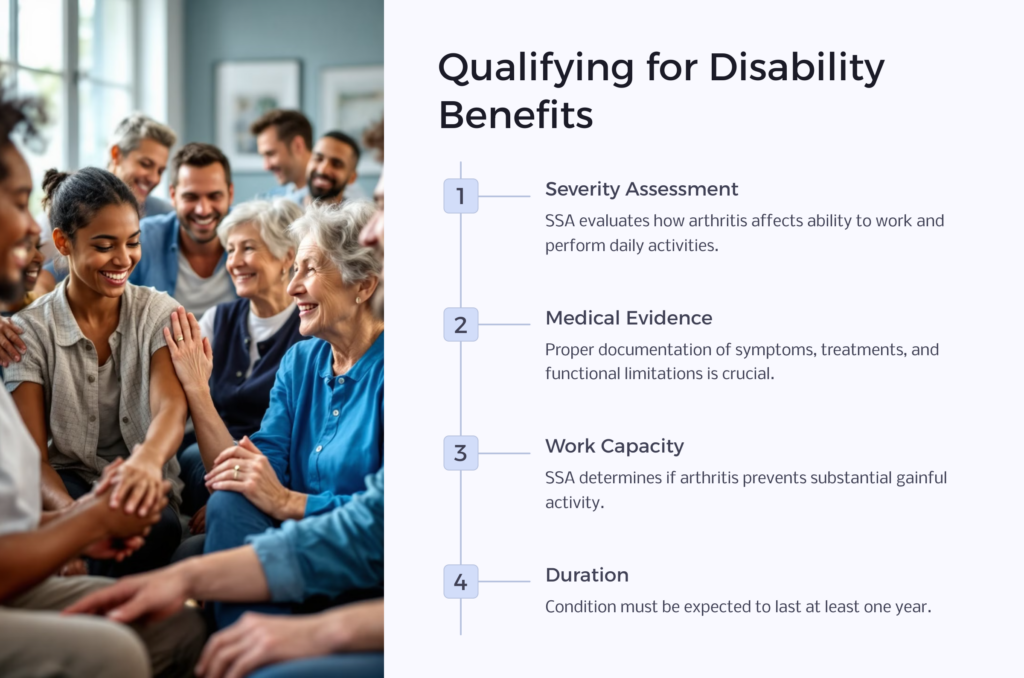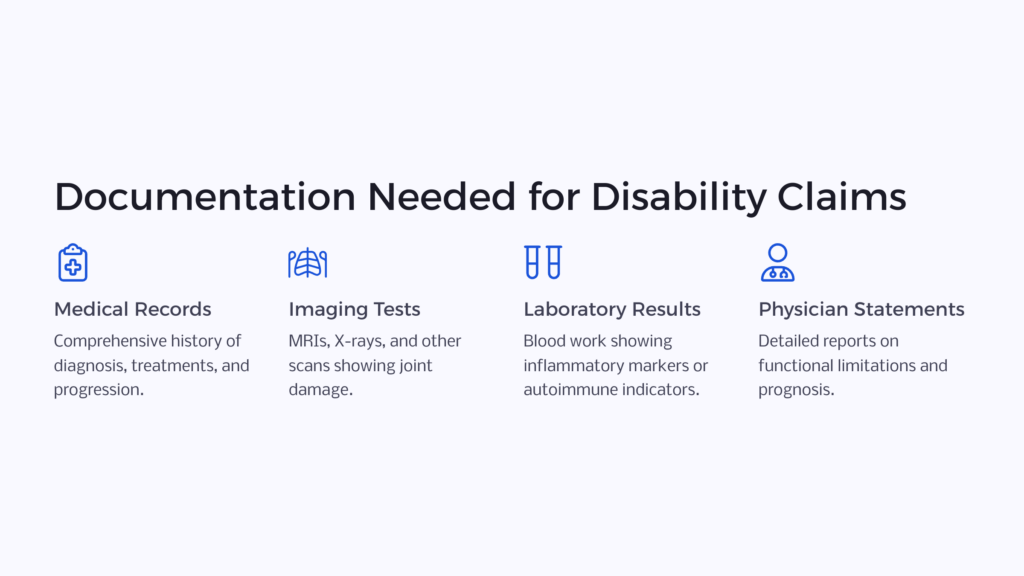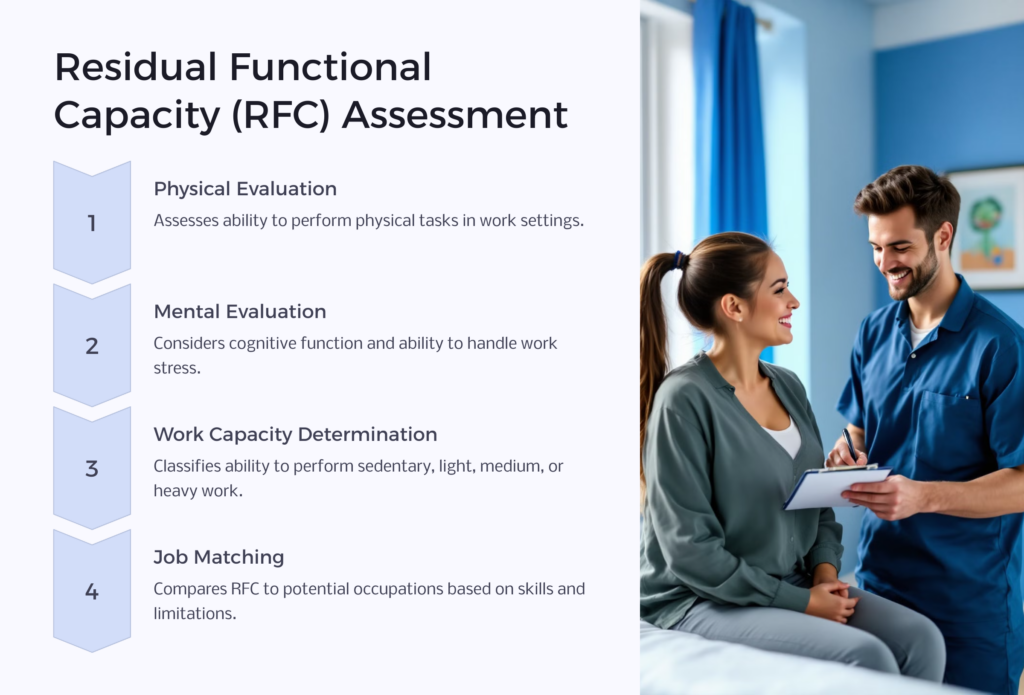Arthritis encompasses more than 100 painful inflammatory joint conditions that affect as many as 53 million American adults and roughly 300,000 children, according to the Arthritis Foundation. Its chief symptoms include tenderness, swelling, and pain in one or more of the body’s joints. These symptoms tend to get more severe with age. Arthritis, besides varying in type, can also vary in severity and level of debilitation – while for some, it’s nothing more than a mild annoyance or inconvenience, for others, arthritis can prove severe enough to prevent their being able to carry out day-to-day work activities or other physical activity.
When this is the case, arthritis sufferers may be eligible for Social Security disability benefits. While more than 100 types of arthritis exist, below is a list of some of the most common types, especially those for which a claimant might expect to be awarded a Social Security disability claim.
8 Types of Arthritis
- Ankylosing Spondylitis
- Gout
- Juvenile Arthritis
- Osteoarthritis
- Pseudogout (CPPD)
- Psoriatic Arthritis
- Reactive Arthritis
- Rheumatoid Arthritis
Is Arthritis a Disability?

Sometimes, arthritis qualifies as a disability. It all depends on the severity and pervasiveness of the arthritis, along with what kind of medical evidence is provided and whether the person is able to work. When reviewing a claim for Social Security disability benefits related to arthritis, the Social Security Administration will consider several factors. For example, they may first look at how the type of arthritis claimed affects a claimant’s ability to walk. Is the arthritis in question affecting major, weight-bearing joints with enough arthritis pain and/or joint deformity that it’s difficult or impossible for the claimant to move about?
Those who suffer symptoms on a chronic and ongoing basis are more likely to be approved for SSDI benefits than those who suffer occasional or acute flare-ups of arthritis. For example, when considering ankylosing spondylitis or other spondyloarthropathies, the SSA will want to see medical imaging that documents the level of flexion of the spine to determine how the chronic condition affects the quality of life.
Keep in mind that one of the steps involved in the review process is to compare a claim to the SSA’s accepted list of qualifying conditions. Generally, rheumatoid, psoriatic, and other autoimmune-related joint diseases are reviewed under the Inflammatory Arthritis listing for the SSA, while osteoarthritis may be classified as a spine or joint issue. Some forms of arthritis are not mentioned at all in the SSA listing, but with the right documentation and proof of disability, benefits may still be rewarded.
Above all, SSA reviewers want to see how the presence of arthritis affects a claimant’s day-to-day activities and functional limitation. Can the claimant engage in substantial gainful activity, depending on whether the current job consists of sedentary work or requires a high level of physical activity? How are daily living activities limited? What about social functioning? These items must be effectively addressed in any Social Security disability benefits claim so that reviewers can make a fully informed decision. A disability attorney has the potential to make sure your claim includes the right kind of medical evidence.
Documentation Needed

Proper medical records are essential in filing a successful disability claim with the Social Security Administration (SSA). Some of these needed records are:
- Test results showing your functional and mobility limitations
- Imaging tests, such as MRIs, CAT scans, x-rays, or PET scans
- Laboratory results for inflammatory arthritis
- Blood work showing inflammatory arthritis or autoimmune disease markers
Standards Needed For Claim Approval
Unfortunately, the Social Security Administration (SSA) does not approve most initial claims for arthritis. To be approved, it is important to submit all the supporting evidence you have. During an initial assessment, the Disability Examiner will determine:
- Does your disease prevent you from working?
- Is your condition expected to last for at least one year from when it caused you to either stop working or reduce your work so that after payment of impairment-related work expenses (IRWEs), your gross wages or net self-employment is not at the level of substantial gainful activity (SGA)? ($2,110 for blind individuals and $1,260 for all others in 2020)
- Have you been getting treatment for at least 3 months? And if so, how are you responding to treatment?
- If you are currently working and earned at the SGA level, did you have impairment-related work expenses (IRWE’s) that dropped your earnings below that amount.
- Is the disease causing chronic pain and swelling and joint motion that makes it painful or restricted to a degree that based on your age, skills, previous jobs, mental capacity, and education are you incapable of working at a Heavy, Medium, Light, or Sedentary level?
- Are you incapable of performing work?
If all those questions show you have severe arthritis by Social Security’s standards and that you cannot work in any occupations that you could do if you didn’t have medical limitation, you should be approved for benefits.
Blue Book to Assess Impairments
SSA has prepared a list of impairments and gathered them in the Blue Book, for their disability examiners as a reference guide. This detailed list provides quick guidance for a review by the examiner to assess if your particular set of limitations is so severe that your work history, age, and education do not have to be considered in a disability determination. Each diagnosis listed must be accompanied by certain findings for the diagnosis to meet the listing and allow approval based on the listing.
SSA recognizes inflammatory arthritis could qualify as a disabling disease if it is accompanied by the following findings.
- Deformity or swelling of an ankle, knee, or hip joint with:
- At least two of the following symptoms: fever, loss of weight, fatigue, or a general feeling of discomfort
- At least two organs or systems affected with one being moderately involved
- Continuing or recurring bouts of inflammatory arthritis with a minimum of two systems impacted along with daily living tasks, cognitive functioning, or social activities being negatively affected
- Being unable to walk because of a deformity or inflammation of a weight bearing joint
- Continuing inflammation of one or more major arm joints in both arms is severe enough to prevent normal daily activities, such as shopping, personal hygiene, feeding oneself, or driving
Spondyloarthropathies (joint disease of the vertebrae of the spine) or Ankylosing Spondylitis (spinal joints becoming inflamed and fused).
How to Qualify for Benefits from Arthritis as a Back Problem
One of the most common osteoarthritis afflictions is when it attacks the spinal vertebrae. To meet the SSA’s spinal listing requirements, you have osteoarthritis diagnosed in your spine, as well as:
- An inflammation of the membrane (arachnoid) which covers spinal cord nerves. This issue would require you to change positions twice or more every couple of hours
- Limiting the motion of the spine due to compression of the spinal nerve root causing problems with walking and bending
- Compression of the spinal canal in the lumbar area causing walking to be extremely difficult
Impairment Listings for Individual Joints
 SSA has specific impairment listings for different joints of the body the disease could attack. A number of these listings deal with a person’s spine. These listings help disability examiners quickly approve cases for benefits if you meet the minimum requirements set out in the listings.
SSA has specific impairment listings for different joints of the body the disease could attack. A number of these listings deal with a person’s spine. These listings help disability examiners quickly approve cases for benefits if you meet the minimum requirements set out in the listings.
If you do not meet those requirements, there is another method to obtain approval for benefits. To accomplish this, you must be able to show the SSA your impairments are so severe they limit your ability to perform tasks required by jobs that you could otherwise qualify for. Examples of such impairments that might qualify you for benefit are being unable to sit for a long period of time, stand or walk for a distance, bend over, pick objects up, push or pull objects, carry objects, or manipulate objects.
Other Ways Your Arthritis Can Qualify as a Disability
If you do not qualify for benefits from the impairment listings for back problems, you may be eligible under a broader classification of a major dysfunction of a joint. To succeed with this category, you must have an obvious joint distortion. Such a distortion would be visible by using medical imaging techniques, such as an MRI. Examples of such impairments are the joint being fused (ankylosis) or a compression of the space in a joint has occurred. Coupled with this would be a history of the loss of a range of motion, along with stiffness and pain in the joint.
A further requirement is the dysfunction must be occurring on both arms. It must exist in at least one hand, a wrist, an elbow, or a shoulder in each arm. Because of this stringent requirement, you must have a great difficulty in performing daily tasks such as preparing meals, performing daily hygiene, or completing simple house cleaning jobs without another person’s assistance.
A second option would be if your dysfunction existed in an ankle, a knee, or a hip causing much difficulty in walking. Illustrations would be if you were unable to climb a set of stairs at a reasonable speed even using a handrail; if you were required to use a walker, two canes, or two crutches; or needed another person’s help in the workplace, around the home, , or in activities such as shopping for groceries.
Residual Functional Capacity

If your illness or injury does not meet the listings, you can still qualify for benefits if your residual functional capacity (RFC) is such that you cannot perform any work that you would be qualified for absent medical limitations. Residual functional capacity is your ability to perform certain physical or mental functions. Your physician, if willing, can complete either a physical or mental RFC form for you. Sometimes the claims examiner will order a consultative examination for you so that an RFC evaluation can be made, but there is no guarantee this will be done. This test may be applied if the more straightforward limitation listings are not met by your particular circumstances.
When an RFC statement is available from your physician or obtained by SSA, it determines your physical or mental work capacity for an eight-hour shift, five-days a week. In the case of a physical evaluation, the final result will show if you are qualified to perform none, sedentary, light, medium, or heavy effort jobs. With the results from this test, the SSA will determine whether you are able to perform any type of work you are suited to perform even with your arthritis restrictions.
If performed, this evaluation is divided into two areas:
- Upper Extremity
If your arthritis affects your arms, hands, or shoulders, your RFC may show you do not have a full capability of lifting, pushing, gripping, or performing manual dexterity tasks, such as typing, writing, or filing. Even sedentary jobs could be difficult for you. - Lower Extremity
If your spine or legs are affected by your arthritis, you could be limited in walking, bending, or climbing. Desk-bound jobs may be the only ones you would be qualified to perform. This type of work would include sitting type jobs and would involve lifting no more than ten pounds. You could be required to stand or walk for up to two hours and carry light objects, so depending on the seriousness of your arthritis; you may even be disqualified for that type of work.
If your rating shows you are unable to perform sedentary jobs, you should be approved for disability benefits. If you are able to function in any of the sedentary, light, medium, or heavy classifications, the Disability Examiner will try to match your age, prior work history, skills, and education to potential occupations to see what other types of jobs you would be qualified to perform. Once you reach an age of 50 or so, the SSA will more likely have the opinion you would not be able to learn a new skill depending on your previous experience and educational background.
Rating Categories
- A sitting job with no lifting is a Sedentary Rating
- A Light work rating would expect you to often carry 10 pound objects and be able to lift 20 pound objects. You would be expected to stand or walk for most of the day
- For a Medium rating work, you should be able to lift 50 pounds and often carry 25 pound objects during the day
- A Heavy rating means you can frequently carry 50 pounds with the ability to lift 100 pounds
Inability to Do Any Work
In addition to the lifting, carrying, standing, sitting requirements, here are other examples to show an inability to do even sedentary work:
- The need to take frequent sick days
- Required to lay down during the day
- Unable to focus on tasks
- Necessity of keeping one leg elevated
- Having vision problems
- Being unable to work in a noisy environment
- Being unable to work with others
- Having balancing difficulties while standing or walking
- Must switch between standing and sitting throughout the work day
8 Types of Arthritis That Might Qualify for SSDI Benefits
Most types of arthritis bring about symptoms ranging from joint pain and stiffness to reduced range of motion, swelling, and redness around the joint. Risk factors for developing arthritis may include age, sex, weight, family history, and history of joint injuries.
Ankylosing Spondylitis
This type of arthritis almost exclusively affects the spine and/or pelvis, bringing with it symptoms like stiffness and pain. However, it’s not unheard of for this condition to occur in other parts of the body. The most common locations for ankylosing spondylitis to appear include the joint between the pelvis and the base of the spine, the vertebrae in the lower back, the cartilage between ribs and breastbone, and hip and shoulder joints.
Over time, ankylosing spondylitis can also lead to vertebrae that are fused together, which can make the spine less flexible and result in a hunched-over posture. When ankylosing spondylitis affects the ribs, breathing may be difficult or painful. The weakening of the lower back vertebrae associated with this type of arthritis puts a patient in danger of compression fractures, which could potentially damage the spinal cord and/or the nerves that run through the spine. This type of arthritis may make a claimant eligible for back pain disability.
Ankylosing spondylitis also is part of a family of autoimmune conditions called spondyloarthropathies that tend to attack where tendons and ligaments connect to bone. Stiffness and pain are the usual symptoms, most usually in the lower back. However, some spondyloarthropathies can attack peripheral joints, like those in the hands and feet. Ankylosing spondylitis tends to affect men more than women, and its signs typically first appear in early adulthood. While it has no specific identified cause, there is a hereditary element to a
kylosing spondylitis – most patients with this type of arthritis demonstrate a particular gene called HLA-B27.
Gout
A buildup of uric acid within a joint leads to this type of arthritis, which can be intensely painful. People with high levels of uric acid in their blood may be at elevated risk for gout, though diet, alcohol consumption, and family history also are powerful factors.
Gout is a complex form of arthritis, and it can affect anyone. By current measures, about 4% of Americans suffer from gout, broken down by nearly 6 percent of males and about 2% of females. Gout is extremely common in the feet, especially the big toe, along with the knee, elbow, wrist, and finger joints. It typically presents in the form of a gout attack, which can come on unexpectedly and lead to pain and soreness that can linger for several days. This form of arthritis almost always appears suddenly, and often in the middle of the night. Many patients report waking during the night with the feeling that their big toe is on fire. Gout also is known to get progressively worse over time, which can lead to limited range of motion in the affected joint.
Juvenile Arthritis
Affecting around 300,000 young people across the United States, juvenile arthritis is actually an umbrella term that comprises more than 100 various childhood and young adult autoimmune and inflammatory conditions. Among them are Kawasaki disease, juvenile fibromyalgia, and juvenile idiopathic arthritis. The most common form of juvenile arthritis is juvenile idiopathic arthritis, which brings symptoms ranging from bone erosion, change in growth patterns and misaligned joints to months of fatigue, fevers, swelling, stiffness, and aching joints. Most juvenile arthritis presents before age 16 – some patients experience only temporary symptoms, while others suffer effects for the rest of their lives.
Osteoarthritis
Osteoarthritis is perhaps the most common form of arthritis. When most people reference, “arthritis,” osteoarthritis is likely what they’re referring to. You may also hear this referred to as degenerative arthritis. The disease is caused by the breakdown of cartilage in the joints, either from repetitive movements or as a simple byproduct of aging. Osteoarthritis affects roughly 27 million adults in the United States.
Normally, the cartilage between bones provides sufficient cushion for the joints to move in an almost frictionless motion. But driven by the breakdown of this cartilage, when osteoarthritis is present, the bones of the body begin to rub against each other without proper cushioning. This bone-on-bone friction can be tremendously painful. It can occur gradually over time, or suddenly as the result of an accident or injury. Osteoarthritis can also lead to bone or joint damage and even the development of bone spurs. Common, day-to-day symptoms of osteoarthritis include morning stiffness, lack of coordination, and soreness of the joints, which can worsen over time.
Pseudogout (CPPD)
Pseudogout (CPPD) is an inflammatory arthritis caused by calcium pyrophosphate crystals building up within a joint. Pseudogout (CPPD) most often appears in the knees, but can develop in any joint in the body.
Psoriatic Arthritis
Like other forms of arthritis, psoriatic arthritis is considered a disability. It’s a form of inflammatory arthritis that affects individuals with psoriasis, a skin condition characterized by red, scaly patches. The Social Security Administration (SSA) recognizes psoriatic arthritis as a disabling condition that can qualify individuals for disability benefits. To be eligible, the severity of the psoriatic arthritis symptoms must significantly limit a person’s ability to perform basic work-related activities.
Keep in mind some differences between rating psoriatic arthritis and general arthritis. One difference between psoriatic arthritis and general arthritis is the inclusion of skin involvement in the evaluation. Unlike general arthritis, psoriatic arthritis often presents with skin manifestations, and the SSA considers both joint and skin impairments in determining disability. Documentation should include dermatological evaluations, descriptions of skin lesions, and their impact on functioning and daily life.
Providing extensive medical evidence that demonstrates the condition’s impact on joint function, skin manifestations, and overall functioning is crucial when applying for disability benefits.
Reactive or Infectious Arthritis
Reactive or infectious arthritis is characterized by inflammation that appears in response to an infection. An infection leading to reactive arthritis might be caused by a wide variety of microorganisms – bacteria, viruses, fungi, or parasites. In addition to skin problems, this type of arthritis often causes joint pain and inflammation, along with inflammation around the eyes. What typically happens is that an infection in one part of the body triggers an inflammatory reaction in joints elsewhere in the body. Root infections sometimes begin in the bladder or the intestinal tract, while symptoms most often appear in the knees, ankles, and feet. Inflammation, redness, and discomfort also can occur in the eyes, skin, and urethra.
You may have also seen this type of arthritis referred to as Reiter’s syndrome. Reactive arthritis is a rare form of arthritis, and symptoms typically disappear within a year.
Rheumatoid Arthritis
Rheumatoid arthritis is an autoimmune disease that causes the immune system to attack the synovial fluid around the joints. The result is often severe inflammation, stiffness and pain, and even joint deformity. Rheumatoid arthritis, according to the Arthritis Foundation, affects roughly 1.5 million American adults, mostly women. Its symptoms run the gamut from morning joint stiffness and stiffness to eventual joint deformities.
Rheumatoid arthritis also may lead to sleep issues, nodules of inflamed cells near the surface of the skin near joints, and concurrent conditions such as Sjögren’s syndrome, which causes extremely dry eyes and mouth. A rheumatoid arthritis patient may also commonly experience burning, numbness, and tingling in the hands and feet.
About 40% of those with rheumatoid arthritis experience symptoms that have nothing to do with the joints – these symptoms can affect the kidneys, nerve tissue, heart, eyes, lungs, skin, bone marrow, and blood vessels. As with many other types of arthritis, rheumatoid arthritis generally goes back and forth between flare-ups and periods of remission.
Disability Benefits for Arthritis
Arthritis is a complex set of inflammatory disorders that bring symptoms that are wide-ranging in their severity and duration. To determine whether a claimant is eligible for Social Security disability benefits related to arthritis disability, the SSA will consider many important factors. If you think your current medical condition might qualify you for this type of disability benefit, it’s a good idea to do as much research as you can, collect as much objective medical evidence as you can to document your disabling condition. You should also consider working with a disability attorney who can help guide you through the process.
Although many claims are denied initially, more are approved during an appeal process. You can represent yourself during this process, but your chances for approval will certainly rise if you have a Social Security Disability lawyer helping you with an appeal. By using an attorney who specializes in Social Security Disability law and procedures, you will be able to benefit from their knowledge in obtaining the properly worded medical paperwork, avoiding appeals or winning an appeal. Understanding the complexities of disability law could result in a favorable decision on your behalf. And, you may be able to avoid an appeal by submitting full information about your condition and limitations for your initial claim without depending on Social Security to request your records.

 Benefits.com Advisors
Benefits.com Advisors
With expertise spanning local, state, and federal benefit programs, our team is dedicated to guiding individuals towards the perfect program tailored to their unique circumstances.
Rise to the top with Peak Benefits!
Join our Peak Benefits Newsletter for the latest news, resources, and offers on all things government benefits.




















